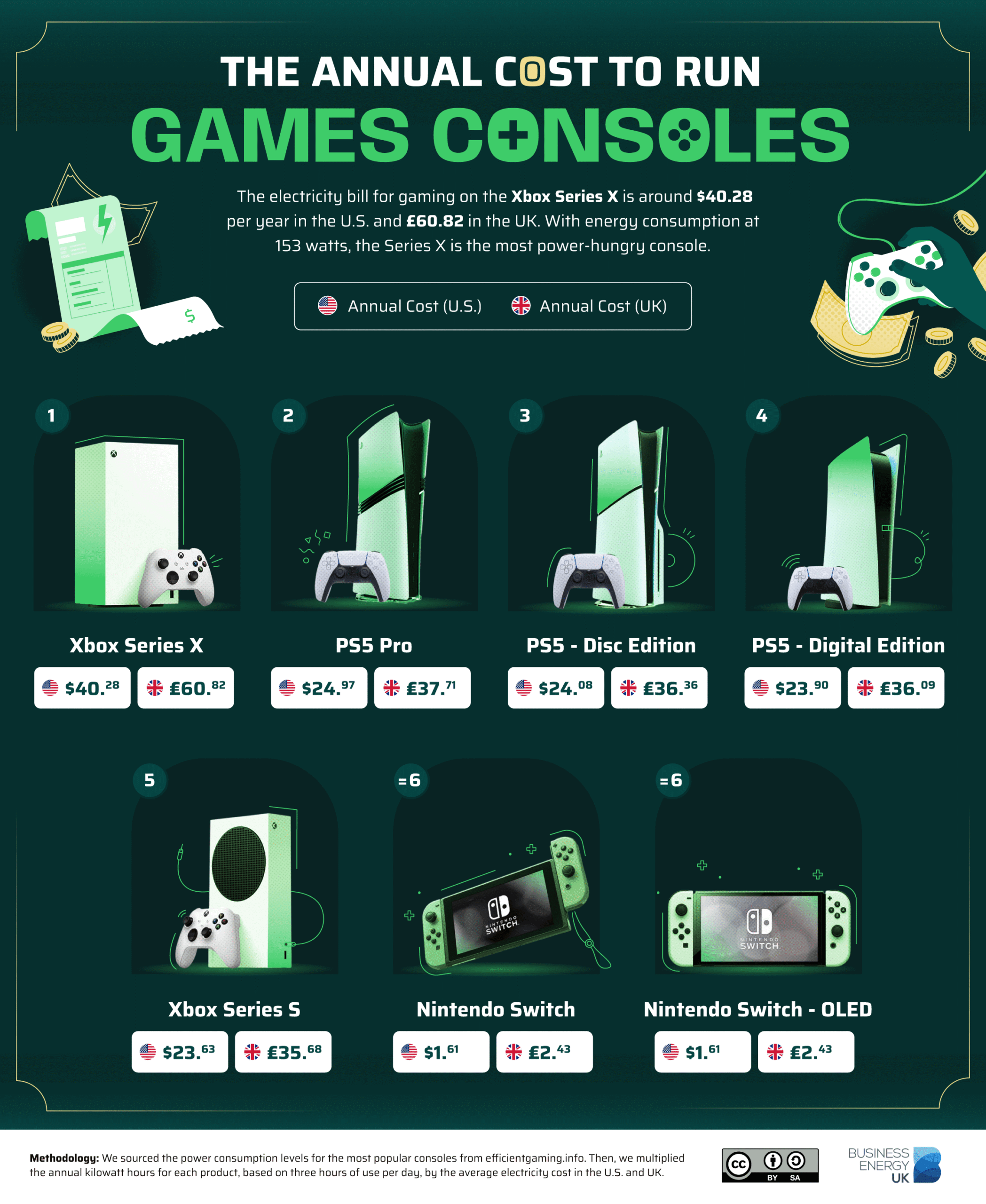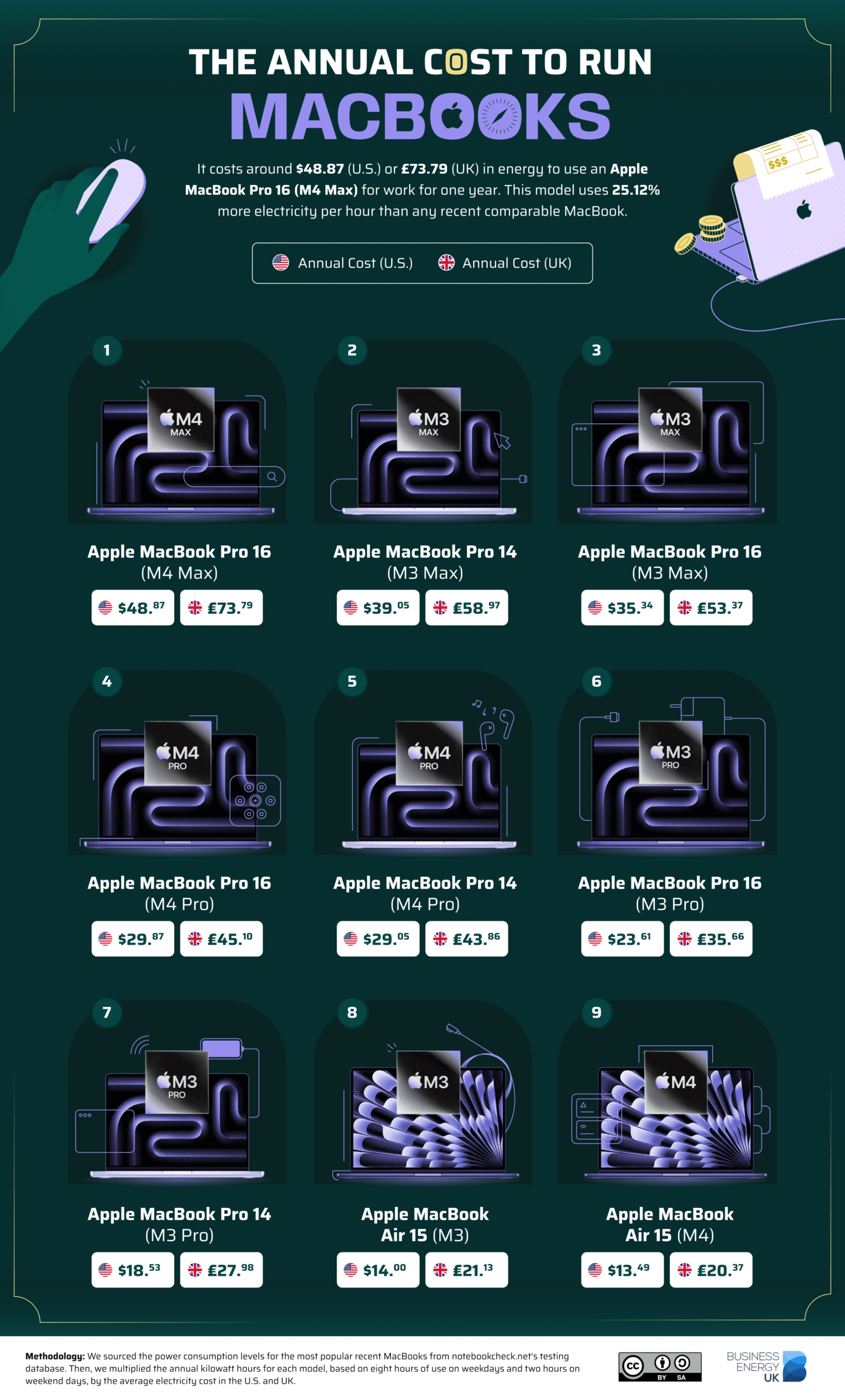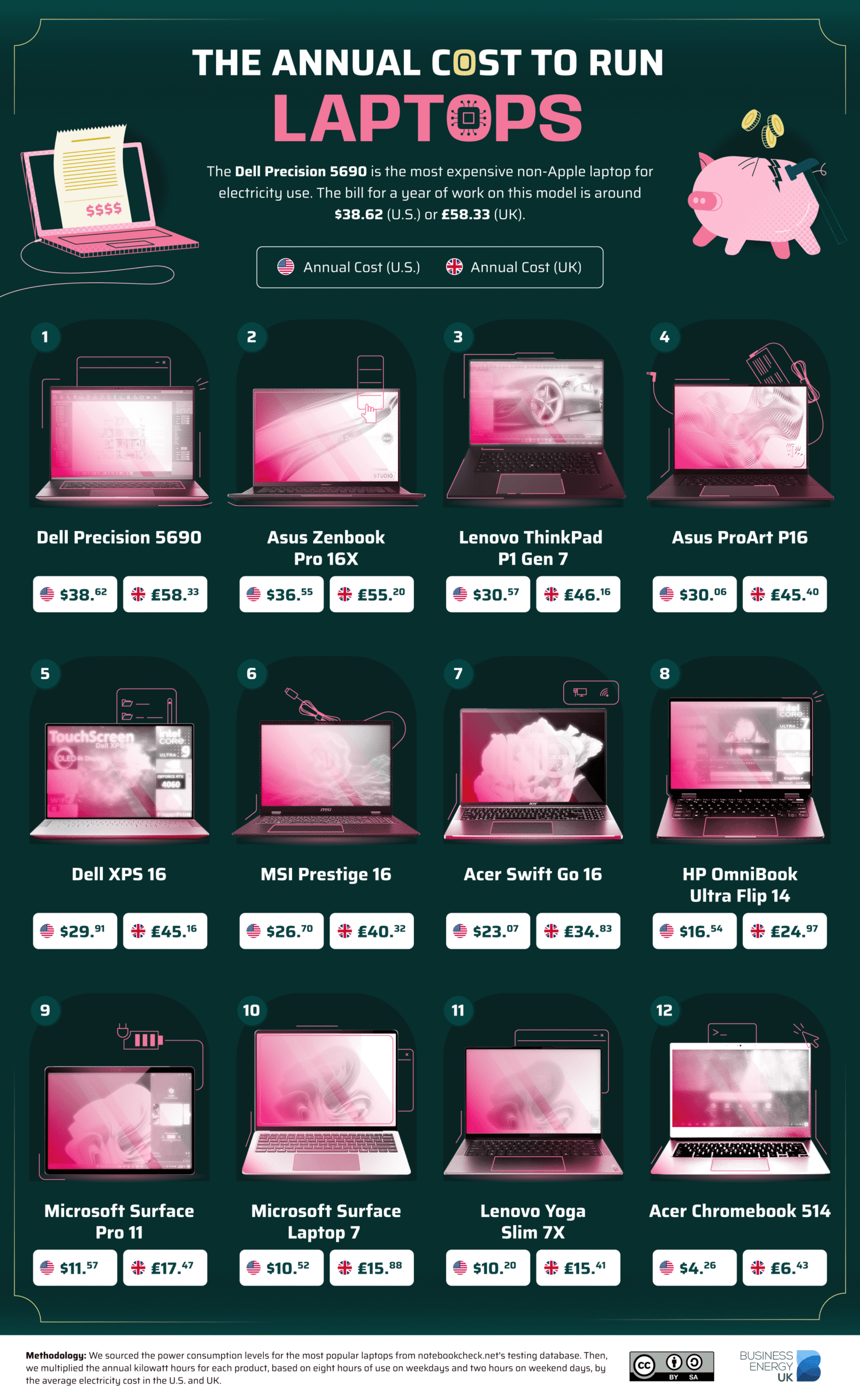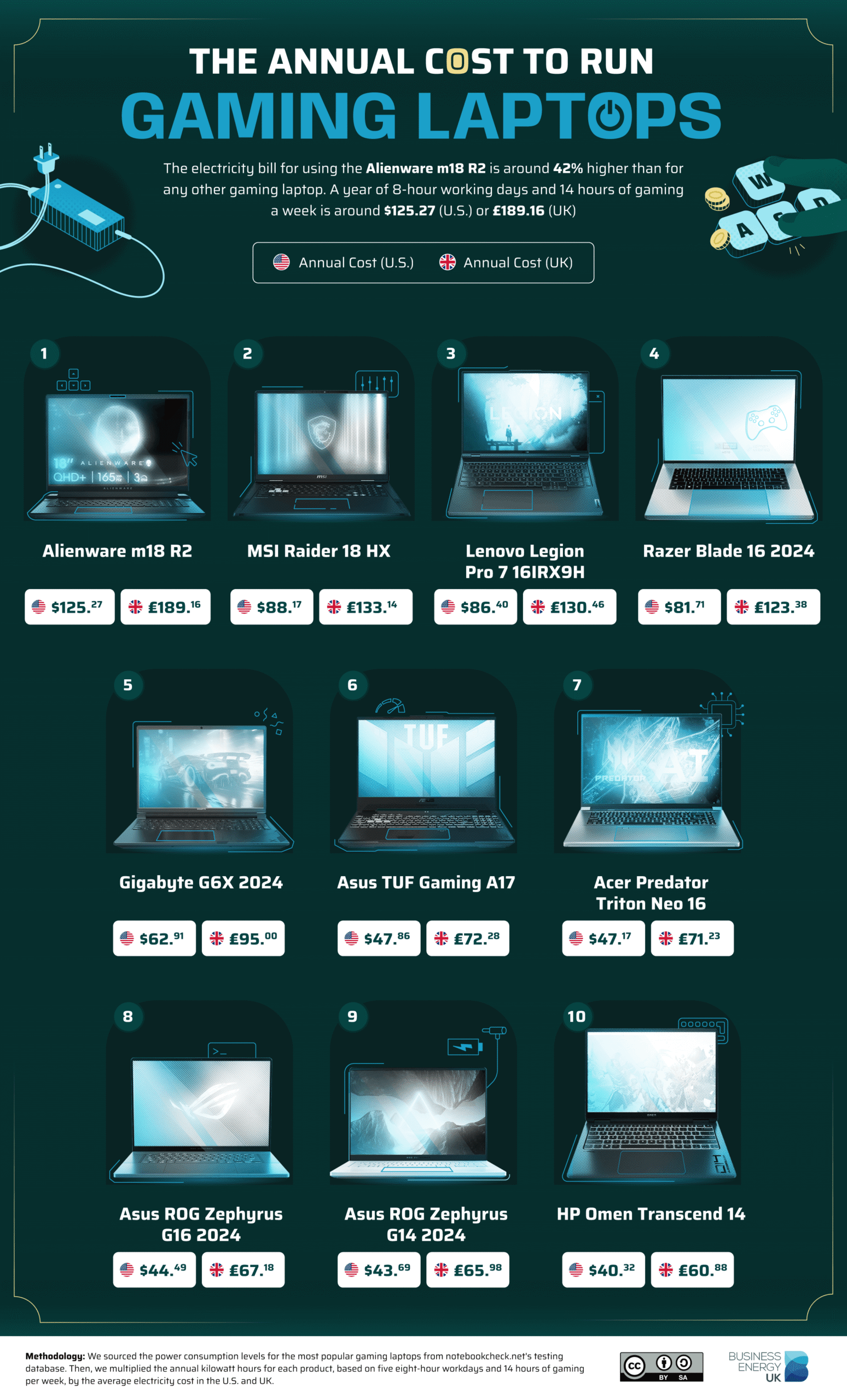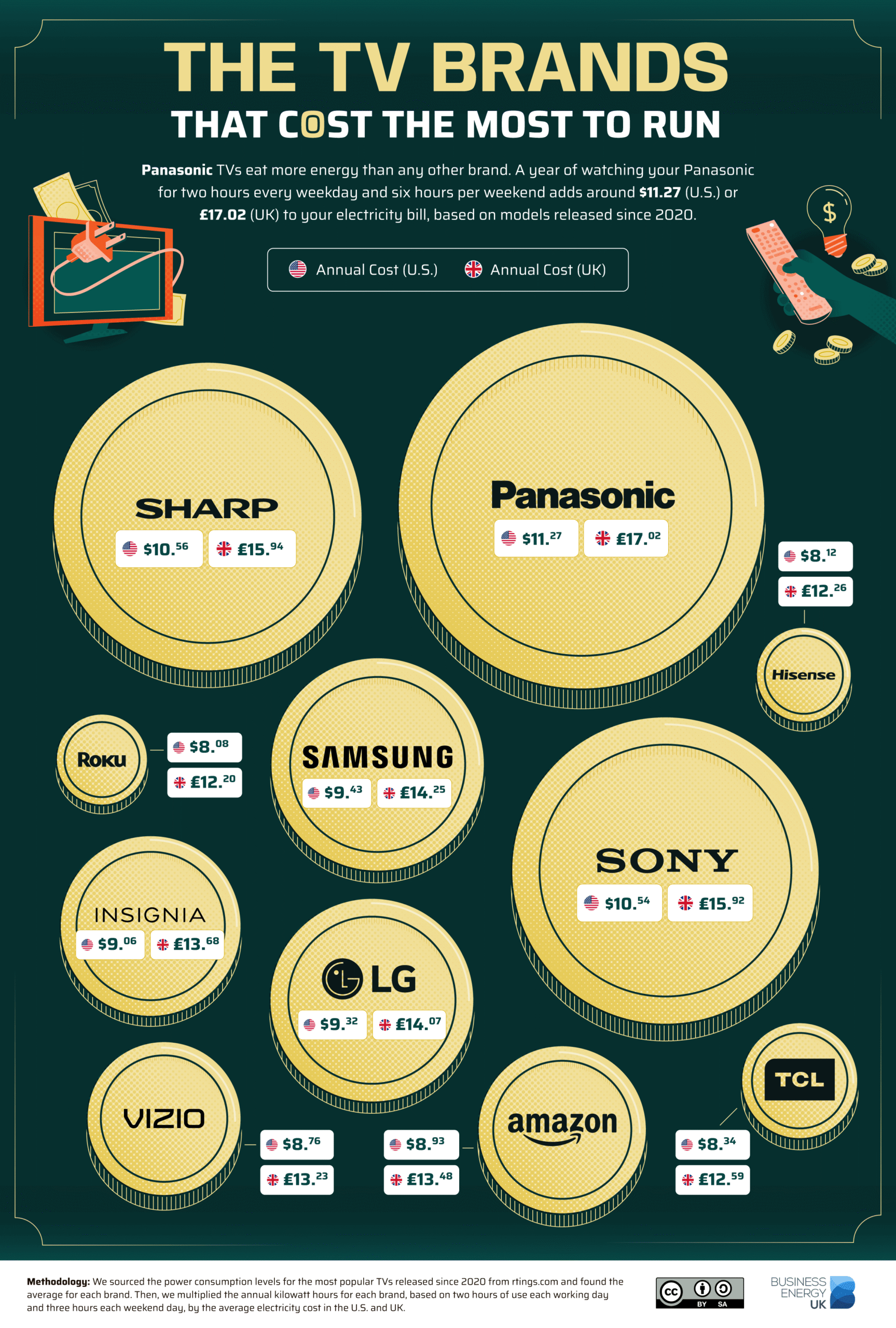The Consumer Electronic Products and Brands That Consume the Most Energy
Energy bills are continuing to rise, with the April 2025 price cap hike adding £111 to the typical UK home’s annual gas and electricity bill.

Households and businesses have hurried to lock or switch their electricity tariff. But the energy crisis has also proved a timely moment to look at how we use electricity in our homes and premises.
Mindful steps from installing loft insulation to unplugging ‘vampire devices’ — electric goods that suck a lot of energy when left on standby mode — can reduce bills and the toll on the environment. But no two devices have quite the same energy footprint, and there are savings to be made by choosing more energy-efficient electronic products at the shops.
To illustrate the difference between comparable electronic goods, Business Energy UK has calculated the annual electricity consumption of different devices (including consoles, laptops and TVs) to reveal the brands and models that cost the most to run, based on the average electricity cost in the the UK and U.S
Key Findings
- The Xbox Series X is the most expensive console to run, costing £60.82 (UK) or $40.28 (U.S.) per year in energy bills for three hours of use per day.
- The Apple MacBook Pro 16 (M4 Max) costs 25.12% more to run than any other recent comparable MacBook.
- The most expensive non-Apple work laptop to use is the Dell Precision 5690, costing £58.33 or $38.62 to use for a year (eight hours on weekdays and two hours on weekend days).
- Panasonic TVs are more power-hungry than other brands — the average annual electricity bill for 16 hours of use per week is £17.02 or $11.27.
The Xbox Series X Uses 61% More Power Than Other Consoles
PlayStations use around two-fifths less electricity than the Xbox Series X, which costs £60.82 (UK) or $40.28 (U.S.) for three hours of daily use for a year. The X series uses 225 kWh (kilowatt hours, or the amount of energy used per hour), also eclipsing the 132 kWh consumption of the lower-spec Xbox Series S.
Microsoft, the Xbox’s producer, rolled out a January 2023 update to default all X and S series consoles to the Shutdown (energy saving) power option as a more eco-friendly alternative to the Sleep (Instant On) mode. However, this only affects the device’s standby “vampire” energy consumption and not the power used during play.
Both the standard Nintendo Switch and the OLED version (with a larger, brighter screen) use just 9 kWh, giving a negligible annual electricity bill of £2.43 or $1.61.
Nintendo has positioned the Switch as a light, portable console, and in that sense, it doesn’t compete with the Xbox or PlayStation; plus, its success is connected to the low-power portability of the design.
However, Nintendo deserves credit for continuing to refine the specs to deliver high-efficiency running and provide more bang for your electricity buck.
| Rank | Product | Annual Cost (U.S.) | Annual Cost (UK) |
|---|---|---|---|
| 1 | Xbox Series X | $40.28 | £60.82 |
| 2 | PS5 Pro | $24.97 | £37.71 |
| 3 | PS5 – Disc Edition | $24.08 | £36.36 |
| 4 | PS5 – Digital Edition | $23.90 | £36.09 |
| 5 | Xbox Series S | $23.63 | £35.68 |
| 6 | Nintendo Switch | $1.61 | £2.43 |
| 6 | Nintendo Switch – OLED | $1.61 | £2.43 |
Apple MacBook Pro 16 (M4 Max) is Hungriest MacBook
What difference can a MacBook model make? In terms of energy consumption, a considerable one.
Apple designs its Air models to be portable first, and the latest — the Apple MacBook Air 15 M4 — has an 18-hour battery life, according to Apple.
Use it on the cable for eight hours on weekdays and two hours on weekend days and you’ll run up a £20.37 or $13.49 electricity bill over 12 months. This is 72.4% less than the bill for using the MacBook Pro 16 (M4 Max).
The MacBook Pro 16 (M4 Max) electricity bill comes in at £73.79 or $48.87 annually. However, it is worth noting that Apple intends this machine for high-performance users processing images, video, sound and gaming and expecting a quick turnaround.
Still, this is significantly more than the Apple MacBook Pro 16 (M4 Pro) (£45.10 or $29.87) — and lower energy use for this model also means you’re less likely to run out of battery when working on the go.
| Rank | Product | Annual Cost (U.S.) | Annual Cost (UK) |
|---|---|---|---|
| 1 | Apple Macbook Pro 16 (M4 Max) | $48.87 | £73.79 |
| 2 | Apple Macbook Pro 14 (M3 Max) | $39.05 | £58.97 |
| 3 | Apple Macbook Pro 16 (M3 Max) | $35.34 | £53.37 |
| 4 | Apple Macbook Pro 16 (M4 Pro) | $29.87 | £45.10 |
| 5 | Apple Macbook Pro 14 (M4 Pro) | $29.05 | £43.86 |
| 6 | Apple Macbook Pro 16 (M3 Pro) | $23.61 | £35.66 |
| 7 | Apple Macbook Pro 14 (M3 Pro) | $18.53 | £27.98 |
| 8 | Apple Macbook Air 15 M3 | $14.00 | £21.13 |
| 9 | Apple Macbook Air 15 M4 | $13.49 | £20.37 |
Dell Precision 5690 Costs Nearly £60 per year in Electricity
We checked the leading work laptops for energy consumption using the same parameters as our MacBook analysis. The most power-hungry laptop is the Dell Precision 5690, with an annual power bill of £58.33 or $38.62.
This is 21% less than the hungriest MacBook but on par with the second hungriest, the Apple MacBook Pro 14 (M3 Max).
As Tech Radar’s review puts it, this level of energy consumption, when seen for the under-the-hood work it represents, is seen as a pro rather than a con for those working with video or games: “this heavy-duty laptop caters to professionals who need the extra power, even at the cost.”
While Microsoft’s Surface range packs a very low power footprint, the Acer Chromebook 514 stands out as the work laptop with by far the lowest associated power bill: just £6.43 or $4.26 per year.
The Chromebook is not intended for the same heavy-duty processing work as a top MacBook or Dell but still offers reliable processing despite its gentle appetite. Creative Bloq calls it “a capable browsing machine that can handle a little photo editing too,” and recommends it as a low impact web-and-Word second computer for those using a MacBook to do the serious stuff.
| Rank | Product | Annual Cost (U.S.) | Annual Cost (UK) |
|---|---|---|---|
| 1 | Dell Precision 5690 | $38.62 | £58.33 |
| 2 | Asus Zenbook Pro 16X | $36.55 | £55.20 |
| 3 | Lenovo ThinkPad P1 Gen 7 | $30.57 | £46.16 |
| 4 | Asus ProArt P16 | $30.06 | £45.40 |
| 5 | Dell XPS 16 | $29.91 | £45.16 |
| 6 | MSI Prestige 16 | $26.70 | £40.32 |
| 7 | Acer Swift Go 16 | $23.07 | £34.83 |
| 8 | HP OmniBook Ultra Flip 14 | $16.54 | £24.97 |
| 9 | Microsoft Surface Pro 11 | $11.57 | £17.47 |
| 10 | Microsoft Surface Laptop 7 | $10.52 | £15.88 |
| 11 | Lenovo Yoga Slim 7X | $10.20 | £15.41 |
| 12 | Acer Chromebook 514 | $4.26 | £6.43 |
Alienware Gaming Laptop Eclipses Power Use of Rival Machines
“My dad is blaming me for the high electricity consumption of the house,” writes an unknown gamer on r/GamingLaptops. While the gamer’s father may be underestimating the appetite of the household electric shower, immersion heater and kettle, he’s right to be concerned about the power consumption of his child’s gaming laptop.
With consumption of up to 700 kWh at full pelt, this category of home electronic product is the most demanding of any in our study.
And the “battlestation” Alienware m18 R2 is 1.4 times as expensive to run as any other we looked at. It costs £189.16 or $125.27 in electricity annually, based on an eight-hour working day on weekdays and 14 hours of gaming per week.
Gaming is a processing-intensive use case. And gaming-oriented laptops, though geared towards gaming, are not optimized exclusively for gaming as consoles are.
However, clever techniques to run these processes more efficiently are being developed, and an Intel report suggests they can use AI to optimize screen refresh rates by refreshing unused parts of the screen at a slower rate than active areas.
Cheaper options are also available. We found three popular gaming laptops that cost under £70 per year to run. The most efficient is the HP Omen Transcend 14 at £60.88 or $40.32 per year.
Despite its low power consumption, the Omen reportedly performs well in gaming at lower resolutions (<1080p), though it “starts to struggle at higher resolutions.”
| Rank | Product | Annual Cost (U.S.) | Annual Cost (UK) |
|---|---|---|---|
| 1 | Alienware m18 R2 | $125.27 | £189.16 |
| 2 | MSI Raider 18 HX | $88.17 | £133.14 |
| 3 | Lenovo Legion Pro 7 16IRX9H | $86.40 | £130.46 |
| 4 | Razer Blade 16 2024 | $81.71 | £123.38 |
| 5 | Gigabyte G6X 2024 | $62.91 | £95.00 |
| 6 | Asus TUF Gaming A17 | $47.86 | £72.28 |
| 7 | Acer Predator Triton Neo 16 | $47.17 | £71.23 |
| 8 | Asus ROG Zephyrus G16 2024 | $44.49 | £67.18 |
| 9 | Asus ROG Zephyrus G14 2024 | $43.69 | £65.98 |
| 10 | HP Omen Transcend 14 | $40.32 | £60.88 |
Panasonic is Biggest Energy Sucker of Top TV Brands
For our analysis of TV power consumption, we calculated the average power consumption by brand on all models released since 2020. The increasing size, brightness and functionality of TV sets has pressured manufacturers to find ways to make them more efficient.
The always-on backlight of the LED screen has been bettered by the development of Mini-LED, which distributes light emission locally on the screen to reduce output.
OLED screens use individually lighting pixels, which theoretically improves the power draw of the LED backlight. However, OLED power consumption soars with increased brightness, countering some of the efficiency improvements. QLED screens, with their added layer of ‘quantum dots,’ use more power.
With all that said, TV energy consumption is still low enough to preclude major differences between the average power use across rival brands. Panasonic TVs run up the highest bills (£17.02 or $11.27 per year) but use only 6.8% more electricity than Sharp or Sony sets.
Roku offers the best efficiency (£12.20 or $8.08). The Roku brand started with streaming sticks that viewers could use to stream internet TV onto their old-school TV.
As such, when moving into television manufacturing, the company’s software processing was already streamlined and efficient, while the TVs’ simple interface makes no big demands on the power supply.
| Rank | Brand | Annual Cost (U.S.) | Annual Cost (UK) |
|---|---|---|---|
| 1 | Panasonic | $11.27 | £17.02 |
| 2 | Sharp | $10.56 | £15.94 |
| 3 | Sony | $10.54 | £15.92 |
| 4 | Samsung | $9.43 | £14.25 |
| 5 | LG | $9.32 | £14.07 |
| 6 | Insignia | $9.06 | £13.68 |
| 7 | Amazon | $8.93 | £13.48 |
| 8 | Vizio | $8.76 | £13.23 |
| 9 | TCL | $8.34 | £12.59 |
| 10 | Hisense | $8.12 | £12.26 |
| 11 | Roku | $8.08 | £12.20 |
Consumer Power to Advocate for Efficient Devices
The energy crisis is not going away fast, and neither is the climate crisis. Thankfully, sophisticated new generations of consumers are looking at the bigger picture and thinking before they buy.
The savings in annual electricity costs may vary from negligible to noteworthy from device to device. But the cumulative effect is felt in the direct reduction of energy consumption and, most pointedly, the consumer’s power to convince brands to design and manufacture their goods responsibly.
Methodology & Sources
To discover the electricity costs of running consumer electronics, we first built a seed list of the most popular consoles, MacBooks, laptops, gaming laptops and TVs.
We then sourced the power consumption for these devices and applied different usage logic to each category to calculate an estimated annual consumption.
Usage logic for each category:
- Consoles = three hours per day
- MacBooks and Laptops = eight hours on weekdays and two hours on weekend days.
- Gaming Laptops = 8-hour working day on weekdays and 14 hours gaming per week.
- TVs = two hours per day on weekdays and three hours on weekend days.
For the MacBooks, laptops and gaming laptops, we sourced the power consumption data from notebookcheck.net’s testing database.
For consoles, we sourced it from https://efficientgaming.info/.
For the TVs, we used rtings.com’s research table and analysed all TVs released since 2020. We then calculated the average power consumption by brand.
Finally, we multiplied the annual kilowatt hours for each product by the average electricity cost in each country to calculate the yearly electricity cost.
The data is correct as of April 2025.

